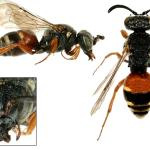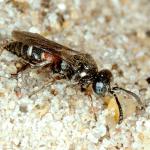Nysson wesmaeli Lepeletier, 1845; Nysson distinguendus Chevrier, 1867; Nysson susterai Zavadil in Zavadil and Šnoflak, 1948; Nysson susterai Zavadil, 1951
A small red and black wasp which is a cleptoparasite of the similar looking Harpactus tumidus (Panzer), occurring in the same sparsely-vegetated sandy areas as its host.
Recorded widely but sparingly across England and Wales as far north as Yorkshire and possibly Northumberland, though precise location(s) relating to the latter county (given by Richards (1980)) have not been found. Within this range, sites coincide with coastal areas and sandy districts. There are several old Channel Islands records and a few modem ones. Abroad, known from most of Europe; also Kazakhstan (Lomholdt, 1975-76).
Listed as Notable B by Falk (1991) (now known as Scarce (Nb)). Very scarce in most districts and considerably less frequent than its host, though both are small and easily overlooked. It has never been regarded as common in the past.
Recorded from heathland, coastal dunes, coastal land slips, open areas in woodland, sandpits, embankments and occasionally gardens. Like its host, it favours sparsely-vegetated or short-cropped areas on dry sandy or clayey soils fully exposed to the sun. It is usually observed running rapidly over such ground or low vegetation during sunny weather, and can be captured by persistently sweeping such areas.
Univoltine; June to September, with males emerging before females.
A cleptoparasite of Harpactus tumidus, and usually obviously occurring alongside that species. The apparent absence of H. tumidus from some sites has led to suggestions that Lindenius albilabris (Fabricius) may be a secondary host.
Umbellifers such as hogweed (Heracleum sphondylium) and wild carrot (Daucus carota).
No information available.
Profile written: 2001
Proofed: March 2012



